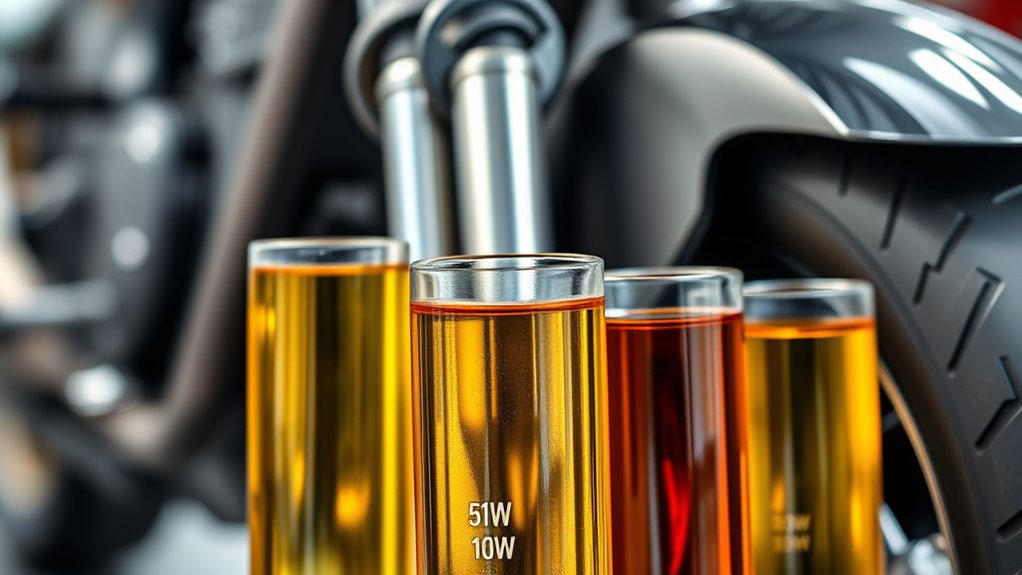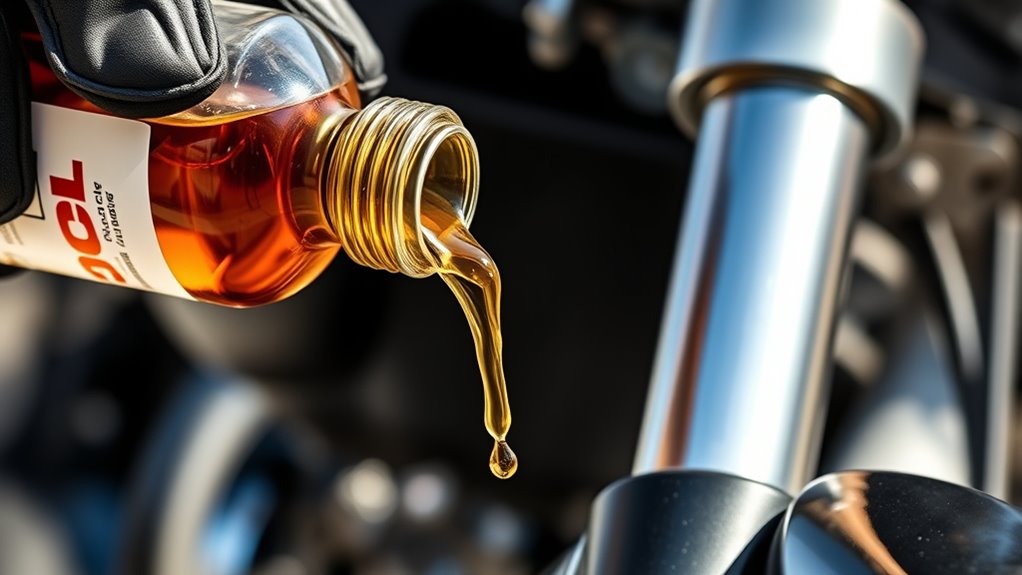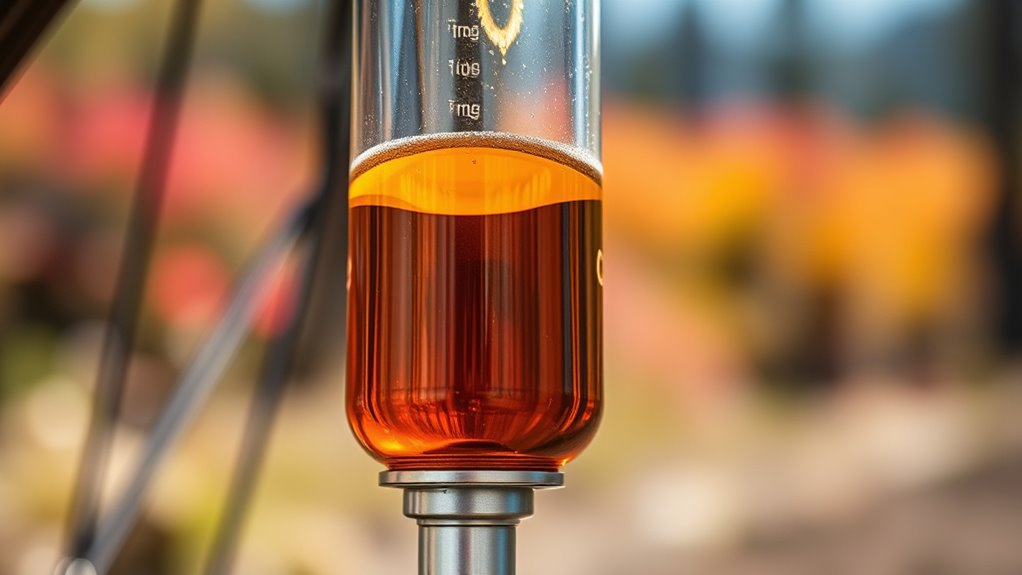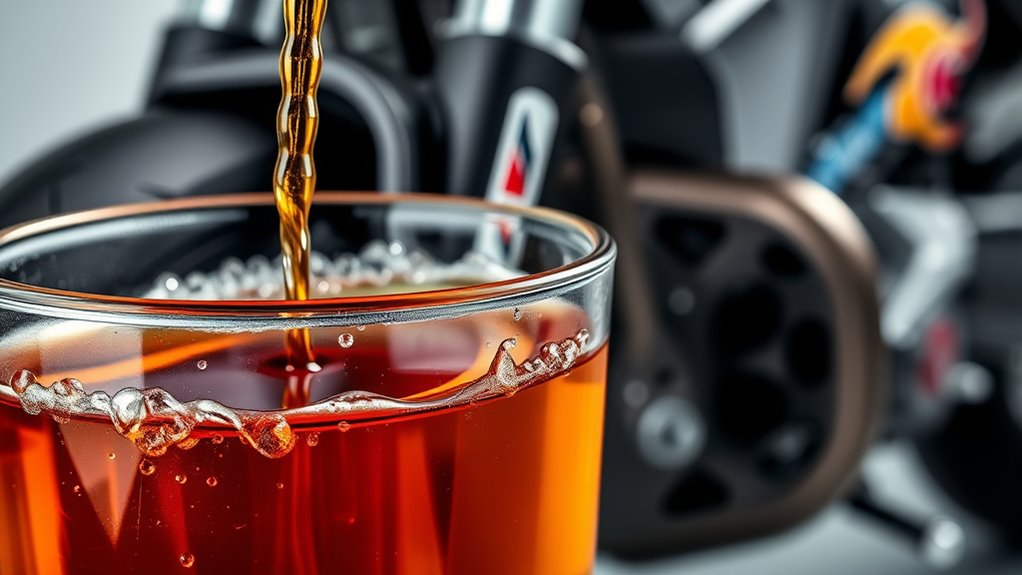Choosing the right fork oil viscosity is key to boosting your bike’s speed and handling. If you ride on smooth surfaces, lighter oils (like 5W or 7W) improve responsiveness, while heavier oils (15W or 20W) are better for rough terrain, offering more damping. Consider your weight, terrain, and riding style to pick the best blend. For tips on fine-tuning and avoiding common mistakes, keep exploring—there’s more to learn to optimize your suspension.
Key Takeaways
- Match fork oil viscosity to riding terrain; thicker oils for rough trails, lighter for smooth surfaces to optimize speed and control.
- Consider rider weight; heavier riders benefit from higher viscosity oils for stability, enhancing speed and damping performance.
- Use viscosity ratings (e.g., 5W, 10W) suited for temperature and riding conditions to maintain consistent damping and responsiveness.
- Adjust oil viscosity based on weather; thicker oil in cold conditions to prevent stiction, lighter oil in hot weather for smoother response.
- Regularly maintain and select quality fork oil to ensure optimal damping, safety, and maximum speed performance.
Understanding Fork Oil Viscosity and Its Role in Suspension Performance

Understanding fork oil viscosity is essential because it directly influences how your motorcycle’s suspension responds to different riding conditions. The viscosity determines the thickness of the oil, which affects how smoothly and quickly the suspension compresses and rebounds. If the oil is too thick, your ride will feel stiff, making it harder to absorb bumps. Conversely, if it’s too thin, the suspension may feel too soft, reducing stability. Viscosity isn’t just about comfort; it impacts handling, control, and safety. Selecting the right fork oil viscosity ensures your suspension performs properly, providing a balance between responsiveness and comfort. By understanding these properties, you can fine-tune your motorcycle’s suspension for different terrains and riding styles. Additionally, using the appropriate viscosity can help prevent mechanical failures caused by improper oil performance.
How Different Viscosities Impact Bike Handling and Speed

Have you ever wondered how the viscosity of your fork oil influences your bike’s handling and speed? Higher viscosity oils are thicker, providing more damping force. This makes your suspension stiffer, improving stability during aggressive riding or sharp turns, but can also lead to a less comfortable ride over bumps. Lower viscosity oils are thinner, offering softer damping. This enhances comfort and allows for quicker responsiveness, helping you absorb small bumps easily. However, too low a viscosity can cause a lack of control at high speeds or during hard braking. Finding the right viscosity balances handling precision and ride comfort, directly affecting your bike’s agility, stability, and overall speed. Adjusting the oil viscosity based on riding conditions can markedly improve your riding experience. Understanding suspension tuning is essential for optimizing performance and safety.
Factors to Consider When Selecting the Right Fork Oil Viscosity

When choosing the right fork oil viscosity, you need to take into account your rider weight, as heavier riders often require thicker oil for proper support. The type of terrain you ride on also matters—rougher trails may call for different viscosities to optimize suspension performance. Additionally, your suspension goals, whether for comfort or responsiveness, influence the viscosity you should select. Considering the impact of viscosity on suspension performance can help you make a more informed choice.
Rider Weight Impact
Your rider weight plays a crucial role in choosing the right fork oil viscosity because it directly affects how the suspension responds under load. If you’re heavier, you’ll need a higher viscosity oil to prevent excessive fork compression and maintain stability. This thicker oil provides better damping, reducing bottoming out and improving control. Conversely, lighter riders benefit from lower viscosity oils, which allow for smoother compression and rebound, enhancing comfort and agility. Ignoring rider weight can lead to compromised handling, either by feeling too stiff or too soft. To optimize suspension performance, match the fork oil viscosity to your weight, ensuring your bike reacts predictably and maintains stability at speed. Properly selected oil helps you get the best performance from your suspension system. Additionally, understanding dynamic suspension behavior can help you fine-tune your setup for various riding conditions.
Riding Terrain Types
Choosing the right fork oil viscosity depends heavily on the type of terrain you’ll ride most often. If you mostly ride on smooth pavement, a lighter oil helps maintain comfort and responsiveness. For rocky trails or rough terrain, thicker oil provides better damping and control, absorbing shocks more effectively. Consider how aggressive your riding style is—more intense riding demands higher viscosity to prevent bottoming out. Additionally, the frequency of riding on uneven surfaces influences your choice; frequent off-road use benefits from a more viscous blend. Incorporating the rustic charm of a farmhouse bedroom, such as vintage furniture and natural materials, can inspire a cozy and authentic atmosphere for your space.
Suspension Performance Goals
Selecting the right fork oil viscosity hinges on your suspension performance goals, which are shaped by how you want your bike to respond under different riding conditions. If you seek a plush, comfortable ride, you’ll need a lower viscosity oil that absorbs small bumps smoothly. For aggressive riding or racing, higher viscosity oils provide increased damping and stability, helping control harsh impacts. Consider whether your priority is comfort, control, or a balance of both. Your riding style, weight, and typical terrain influence these goals. Clear understanding of what you want your suspension to achieve guides your choice. Ultimately, selecting the appropriate viscosity ensures your bike responds predictably, enhancing safety and efficiency on every ride. Additionally, understanding IRA investment strategy can help optimize your overall financial planning for retirement.
Comparing Common Fork Oil Viscosity Ratings and Their Uses

Understanding fork oil viscosity ratings helps you choose the right fluid for your riding style. Different ratings indicate how the suspension responds and what applications they suit best. Let’s compare common ratings and see which ones match your riding needs. Using the proper viscosity rating can significantly improve your bike’s handling and comfort.
Viscosity Ratings Explained
Viscosity ratings provide a standardized way to compare fork oils and determine their suitability for different riding conditions. These ratings, like 5W, 10W, or 15W, indicate how thick the oil is at specific temperatures, affecting damping and performance. A lower number means the oil flows more easily at cold temperatures, improving cold-weather performance. Conversely, higher numbers suggest thicker oil, which offers better support during aggressive riding or heavy loads. Understanding these ratings helps you choose the right oil for your bike’s needs. Keep in mind:
- The “W” stands for winter, indicating cold flow characteristics
- Lower ratings are better for cold starts
- Higher ratings suit high-speed stability
- Viscosity impacts damping, ride quality, and responsiveness
Viscosity’s impact on performance can influence how well your suspension reacts under different riding conditions.
Application Suitability Highlights
Choosing the right fork oil viscosity depends on your riding style and conditions. Lighter oils, like 5W or 7W, suit smooth, fast-paced riding on well-maintained tracks, offering quick response and minimal resistance. Heavier oils, such as 15W or 20W, provide better damping and control during rough terrain or heavy loads. The table below highlights typical uses:
| Viscosity Rating | Application Suitability |
|---|---|
| 5W / 7W | Lightweight riding, sport bikes, smooth surfaces |
| 10W / 15W | Standard riding, moderate trail conditions |
| 20W | Heavy-duty, rough terrain, off-road riding |
Match your oil choice to your riding environment for optimal performance and safety. Proper maintenance of fork oil viscosity ensures your suspension functions effectively, enhancing safety and riding experience.
Practical Tips for Changing and Maintaining Your Fork Oil

Regularly changing and maintaining your fork oil is essential for ideal suspension performance. Fresh oil ensures smooth operation, proper damping, and prevents wear on internal components. To get it right, always follow your motorcycle manufacturer’s recommended intervals and procedures. Use the correct tools, like a proper wrench and a catch basin, to avoid messes. Before draining, raise your bike securely and fully extend the forks to release pressure. When refilling, gently pump the forks to remove air bubbles and ensure even oil distribution. Keep track of the oil type and viscosity to match your riding style. Additionally, understanding fork oil viscosity can help you select the appropriate blend for your specific riding needs.
- Use quality oil that meets specifications
- Keep the workspace clean to prevent contamination
- Regularly inspect for leaks or damage
- Record maintenance dates for future reference
Adjusting Viscosity for Specific Riding Conditions and Styles

Adjusting the oil viscosity in your forks allows you to fine-tune your suspension’s performance to match different riding conditions and styles. If you’re riding on rough trails, opt for thicker oil to improve damping and prevent bottoming out. For smoother, high-speed rides, lighter oil offers better responsiveness and feedback. When riding in cold weather, slightly thicker oil can compensate for increased viscosity, maintaining consistent performance. Conversely, in hot conditions, lighter oil prevents excessive stiffness. Consider your riding style—aggressive riders benefit from thicker oils for stability, while casual riders may prefer lighter blends for comfort. Experiment with different viscosities to find the perfect balance for your needs, ensuring your suspension performs optimally whether you’re tackling rugged terrain or cruising on smooth pavement.
Frequently Asked Questions
How Often Should I Change My Fork Oil for Optimal Performance?
You should change your fork oil every 20,000 to 30,000 miles or at least once a year, depending on riding conditions. Regularly inspecting for signs of contamination or degraded performance helps maintain peak handling. If you notice increased fork stiction, poor damping, or leaks, it’s time for a change. Keeping fresh oil ensures smooth operation, better control, and longer-lasting suspension components. Don’t wait too long to service your forks for the best ride quality.
Can Using Improper Viscosity Oil Damage My Suspension System?
Using improper viscosity fork oil can definitely harm your suspension system. If the oil is too thick, it won’t flow freely, causing your suspension to become stiff and unresponsive. Conversely, if it’s too thin, it won’t provide enough damping, leading to a bouncy ride. Over time, this stress can wear out seals and internal components. Always choose the recommended viscosity to guarantee smooth operation and prevent costly damage.
Are There Environmentally Friendly Fork Oil Options Available?
Think of eco-friendly fork oil options as a gentle rain nourishing your bike’s delicate suspension. Yes, environmentally conscious choices exist, crafted to reduce ecological impact while maintaining performance. You can opt for biodegradable or synthetic blends that break down more easily, protecting both your ride and the planet. By choosing greener oils, you’re not just riding faster—you’re helping preserve the trails and environments you cherish.
How Does Temperature Affect Fork Oil Viscosity and Bike Handling?
You’ll notice that temperature substantially impacts fork oil viscosity and your bike’s handling. When it’s cold, the oil thickens, making your suspension stiffer and less responsive. Conversely, in hot weather, the oil thins out, providing smoother, more plush handling. To keep your ride consistent, choose a viscosity suited for your typical riding temperatures, and consider adjustable or temperature-specific oils to maintain ideal performance year-round.
Is It Necessary to Upgrade Fork Oil Viscosity for Racing Versus Casual Riding?
When you race, upgrading your fork oil viscosity can substantially improve handling and stability, especially under high stress. Higher viscosity oils resist rapid compression and rebound, giving you more control at speed. For casual riding, standard viscosity works fine, offering a comfortable ride. So, if you’re pushing your bike on the track or rough terrain, upgrading is usually worth it. Otherwise, stick with your regular oil for everyday comfort.
Conclusion
Choosing the right fork oil viscosity can boost your bike’s handling and speed, making every ride smoother. Did you know that riders who regularly update their fork oil report a 15% improvement in suspension performance? By understanding viscosity and how it affects your ride, you can fine-tune your suspension for ideal speed and control. Keep an eye on oil quality and viscosity ratings to stay ahead in performance and enjoy a safer, more responsive ride.









